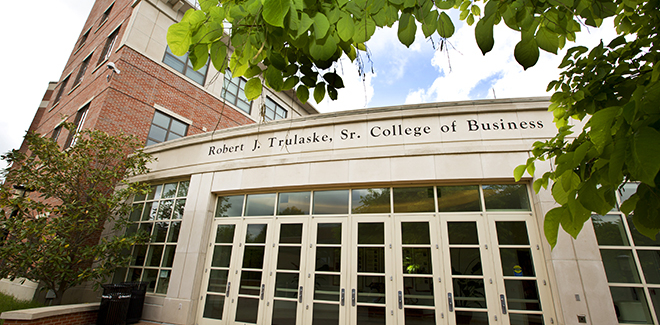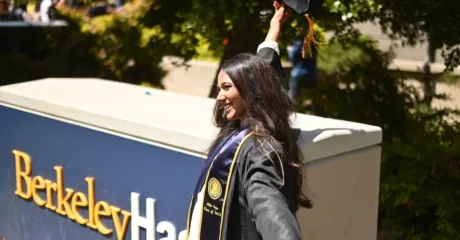Nestled in the quaint college town of Columbia, Missouri is the 54th ranked business school on the third annual Poets&Quants’ ranking. Those lumping Missouri as a fly-over state have likely never stepped foot in the town of a little more than 100,000, which is one of the most educated and culturally rich towns in the middle of the country. Despite being a two-hour drive from any significant metropolitan area, it hasn’t slowed down the school’s ability to get it’s graduates full-time career positions soon after graduation.
“We have extraordinary success with placement for our students,” says Mary Marrs, the assistant dean of undergraduate programs at the University of Missouri Trulaske College of Business.
Indeed, while the school placed 49th in both admissions and academic experience categories, Trulaske jumps to 34th in employment, buoyed by a required business internship and greater than 91% placement rate for its Class of 2016 within 90 days of graduation.
From the moment students arrive on campus, they begin work in the required Professional EDGE program. To be sure, the professional EDGE program is the main unique selling point of a Trulaske degree, which includes six majors to choose from. Established on a point system, students must earn 200 “points” before graduating. Points are earned by attending campus workshops and events. According to the school, the EDGE program offers 200 workshops a semester, ranging from topics such as how to work a career fair to resume building to dressing for success. The workshops are broken into three broad topic areas of “inspire others,” “emotional and social skills,” and “individual performance.” Students must complete a minimum of 70 points before being allowed to move into “upper-level” business courses.
Once accepted into those courses, the students must finish out the 200 points and complete BA 4500, the required internship course. Within the course, Marrs says, students must go through a “professional competency model,” created by industry partners and designed to give students a “360-degree” evaluation of the competencies. “That’s why we consistently see placement percentages north of 90,” Marrs believes.
100% OF CLASS OF 2016 HAD AN INTERNSHIP BEFORE SENIOR YEAR
Trulaske was the only school to report a perfect 100% in any placement category, which came through the required internship, which takes place before senior year. While the internship is required, it’s certainly not handed to the students, Marrs says. “The students aren’t given an internship. They have to hustle for it on their own,” Marrs says. “Our students graduate with 1.7 internships.”
And the course credit certainly isn’t given to the students, either. Students must complete a minimum of 120 hours of work and spend at least eight consecutive weeks at the internship. Also, Marrs says, before even getting the internship approved, students must submit an application with their duties as an intern. The school evaluated the internship beforehand to ensure students would put in action what they learned in the classroom. Once the internships get going, students have regularly scheduled calls with their internship course instructors, consistent supervisor meetings, and a final presentation for their internship supervisor.
The requirement has created an interesting mindset among Trulaske students, Marrs says.
“They have developed the attitude of ‘I don’t need one internship. I need two internships to compete,'” she says.
CORNELL LEADERSHIP PROGRAM UNIQUE OPPORTUNITY FOR HIGH ACHIEVING STUDENTS
A gem within the Missouri undergraduate experience for high achieving high school students is the Cornell Leadership Program. High school students scoring higher than 1320 on the SAT and 28 on the ACT may submit an application for one of 30 spots in the four-year-long program. Accepted students receive mentoring from upper-level students and alums, along with traveling the country and the world meeting with top execs.
“They are having opportunities to question some of the greatest business minds in the world,” Marrs says of the students in the program. This past year, Marrs says, students went on trips to Denver, Dallas, Cuba, Nicaragua, and Chile, among other locations. “These are the students that go to Wall Street,” Marrs notes. “They have incredible opportunities.”
Marrs says the leadership program has established a pipeline of sorts to Wall Street jobs. Investment-minded students also have the opportunity to manage the Mizzou Investment Fund alongside other undergrads and MBAs. Through the Investment Management Fund course, students manage more than $1.6 million of the university’s endowment. Plus, Marrs says, students can take the Warren Buffett course the school offers, which includes a trip to meet with the legendary investor.
FROM COLUMBIA, MISSOURI TO WALL STREET
Still, it’s a relatively small number of students who leave Columbia, Missouri for Wall Street, which is reflective in the school’s low average salaries for the Class of 2016. Marrs says salary is a “concern,” but the majority of Trulaske students come from Missouri, which has a lower cost of living compared to pretty much every other state. Also, Marrs points out, Trulaske has a “fair” amount of graduates joining the Peace Corps or going to work for a nonprofit organization, something that is representative of the school’s student population.
“This generation of students have a very strong service-oriented interest,” Marrs says, noting there is actually a required service program in the Professional Development Program. “Students seek out those opportunities,” she continues. “They want to make the world a better place.”
The point, Marrs explains, is a Mizzou business degree is more nimble than what she believes is a common perception.
“Students can go to Wall Street with a degree from Mizzou. But they can also go to a nonprofit in the Midwest,” she says.
MORE INTERNATIONAL INTERNSHIPS ON THE HORIZON
On the horizon for the school is the continued development of its international internship presence. Marrs says next year 48 students will complete internships around Beijing, China. The same program will also be created in Prague, Czech Republic soon.
Despite having nearly 5,000 students enrolled in the undergraduate business program, Marrs says Trulaske provides a smaller community setting within the larger land grant university. “There is very much a family feel to it,” she says, noting students have direct access with career coaches and advising. “All of these programs create a community,” she adds.
Plus, for Missouri residents, there is likely no better degree for the money. In-state students can earn the degree and live on campus for a total four-year cost of less than $78,000. For out-of-state students, the number climbs to less than $135,000 — still cheaper than many options surrounding Mizzou in the rankings. However, the school did not disclose scholarship or debt data, so it’s unclear just how much business students are receiving in aid and how much debt they are taking on.
For Marrs, one of the most important aspects of Trulaske is the school’s community and alumni.
“We have a unique commitment to our students while they are on campus and afterward,” Marrs says. “Everywhere we go, the alumni are so excited to see the students. And they want to network with them and help them find internships and full-time employment. And they just want to give back. They are so engaged.”
Where The Class of 2016 Went To Work:
AdKarma: 6
Cerner: 29
Dish Network: 8
Edward Jones: 12
Insight Global: 6
Kraft Heinz: 7
State Street: 7
Target: 7
TEKsystems: 8
TQL: 6
Veterans United: 6










